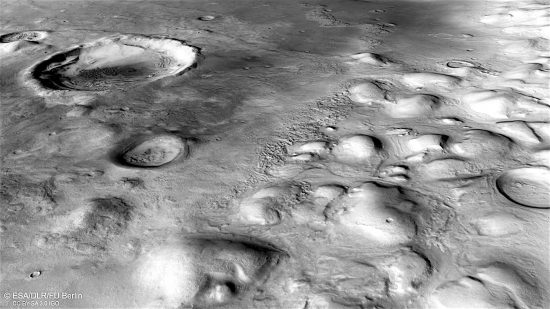
Colles Nili on Mars, thought to contain “ice vaults”. Credit: ESA/DLR/FU Berlin, CC BY-SA 3.0 IGO
Oct 17, 2016
Mars is a frozen graveyard.
There are geographic regions on Earth that are difficult to explain with conventional theories. Norway and Greenland exhibit deep, brachiated channels that penetrate inland for hundreds of kilometers. The fjords have steep-walled side branch canyons whose outlets are far above the water level. Although the consensus theory of glaciation and ice movement is used to explain fjords, those side canyons and the fjords, themselves, resemble innumerable Lichtenberg figures, a formation caused by electricity.
A major anomaly when it comes to an erosion theory of fjord formation is that inland mountain ranges and peaks reflect the shape of the coastal formations except that they are raised above the landscape instead of cut in. Similar structures in Patagonia are known as “inverted relief”—valleys are ridges and mountain peaks are sunken, terraced craters.
Other territories in Russia compare with Scandinavia: the Siberian Traps and the Putorana Plateau. 600,000 square kilometers are dominated by the same kind of Lichtenberg figures that carved western Norway and eastern Greenland. The same process might have created both topographies when colossal forces gripped the high latitudes of Earth, wrenching pulverized stone out of the surface in powerful, vertical electric fields, coupled with traveling currents of electricity. Subsurface materials were literally exploded into space or thrown to the winds for thousands of kilometers.
According to a recent press release, topography on Mars was discovered that resembles what are thought to be ice-based structures seen on Earth, including the aforementioned inverted relief. In previous Picture of the Day articles, similar terrain on Mars was referred to as “dendritic ridges”: raised trackways seen most often on the slopes of Olympus Mons.
Mars is supposed to be covered with permafrost since the annual mean temperature of the regolith is approximately 50 below zero Celsius. It so cold in the northern and southern latitudes that carbon dioxide gas freezes, blanketing the terrain with dry ice. Planetary scientists think that any water remaining on Mars “must be” mixed with thick icy soils because the atmosphere is so thin that water-ice sublimes directly into vapor. Since ice rather than liquid water is thought to predominate, it “must have been” Martian glaciers rather than Martian floods that excavated the anomalous terrain.
Periglacial landforms occur on the margins of glaciers. Theories suggest that polygonal fractures, stone circles, wide pits, scalloped cliffs and dirt-covered mounds “naturally” appear when ice between soil grains melts and then refreezes. Expansion and contraction force the material to sort itself according to density and size.
On Earth, varves, moraines and loess require theoretical mountains of ice to push mounds of soil and rock ahead of their million-ton flanks. In so doing, the gravel and sand is supposed to be sorted by the glacial movement and piled-up into distinctive formations.
In an Electric Universe, powerful electric arcs that once impacted Mars are assumed. The incredible energy released by plasma discharges created sinuous rilles, flat-floored craters, “railroad track” patterns in canyons and craters, intersecting gullies with no debris inside them, giant mesas with Lichtenberg “whiskers” and steep-sided ravines wending through landscapes dotted with circular uplifts.
If Mars was affected by planetary lightning bolts and was not flooded with ice or water moving across the surface, ideas about similar observations on Earth should be reconsidered. Rather than ice, it was fire that birthed the gods.
Stephen Smith












